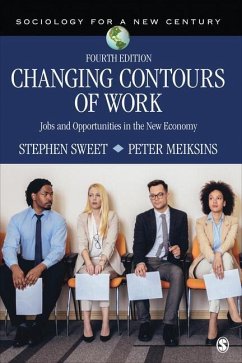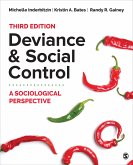- Broschiertes Buch
- Merkliste
- Auf die Merkliste
- Bewerten Bewerten
- Teilen
- Produkt teilen
- Produkterinnerung
- Produkterinnerung
A rich analysis of the American workplace in the larger context of an integrated global economy. The authors frame the development of jobs in an international comparative perspective, revealing the historical transformations of work and the profound effects these changes have had on lives, jobs, and life chances.
Andere Kunden interessierten sich auch für
![The Invisible Woman The Invisible Woman]() Joanne E BelknapThe Invisible Woman190,99 €
Joanne E BelknapThe Invisible Woman190,99 €![Deviance and Social Control Deviance and Social Control]() Michelle L InderbitzinDeviance and Social Control174,99 €
Michelle L InderbitzinDeviance and Social Control174,99 €![Criminal (In)Justice Criminal (In)Justice]() Aaron FichtelbergCriminal (In)Justice149,99 €
Aaron FichtelbergCriminal (In)Justice149,99 €![Sociology of Organizations Sociology of Organizations]() Sociology of Organizations227,99 €
Sociology of Organizations227,99 €![Policing Policing]() Carol A ArchboldPolicing192,99 €
Carol A ArchboldPolicing192,99 €![The Tao of Statistics The Tao of Statistics]() Dana K KellerThe Tao of Statistics49,99 €
Dana K KellerThe Tao of Statistics49,99 €![Fundamentals of Research in Criminology and Criminal Justice Fundamentals of Research in Criminology and Criminal Justice]() Ronet D BachmanFundamentals of Research in Criminology and Criminal Justice227,99 €
Ronet D BachmanFundamentals of Research in Criminology and Criminal Justice227,99 €-
-
-
A rich analysis of the American workplace in the larger context of an integrated global economy. The authors frame the development of jobs in an international comparative perspective, revealing the historical transformations of work and the profound effects these changes have had on lives, jobs, and life chances.
Hinweis: Dieser Artikel kann nur an eine deutsche Lieferadresse ausgeliefert werden.
Hinweis: Dieser Artikel kann nur an eine deutsche Lieferadresse ausgeliefert werden.
Produktdetails
- Produktdetails
- Verlag: Sage Publications
- 4th edition
- Seitenzahl: 368
- Erscheinungstermin: 17. August 2020
- Englisch
- Abmessung: 228mm x 154mm x 22mm
- Gewicht: 466g
- ISBN-13: 9781544305691
- ISBN-10: 1544305699
- Artikelnr.: 59913191
- Herstellerkennzeichnung
- Libri GmbH
- Europaallee 1
- 36244 Bad Hersfeld
- gpsr@libri.de
- Verlag: Sage Publications
- 4th edition
- Seitenzahl: 368
- Erscheinungstermin: 17. August 2020
- Englisch
- Abmessung: 228mm x 154mm x 22mm
- Gewicht: 466g
- ISBN-13: 9781544305691
- ISBN-10: 1544305699
- Artikelnr.: 59913191
- Herstellerkennzeichnung
- Libri GmbH
- Europaallee 1
- 36244 Bad Hersfeld
- gpsr@libri.de
Stephen Sweet is Associate Professor and Chair of Sociology at Ithaca College and formerly the associate director of the Cornell Careers Institute, a Sloan Center for the Study of Working Families. He has written a number of articles on the challenges confronting working families, focusing on the issues of concern to dual career couples across the life course. His studies have appeared in a variety of publications, including the New Directions in Life Course Research, Journal of Vocational Behavior , Journal of Marriage and the Family, Innovative Higher Education, The International Journal of Mass Emergencies and Disasters, Journal of College Student Development, and Community, Work, and Family. Stephen's other book with SAGE is The Work-Family Interface. He has also published The Handbook of Work and Family with co-authors Marcie Pitt-Catsouphes and Ellen Ernst Kossek; Managing Careers in the New Risk Economy, with co-investigator Phyllis Moen; College and Society: An Introduction to the Sociological Imagination, and Data Analysis with SPSS: A First Course in Applied Statistics. Stephen has been the recipient of a Sloan Officers Grant to study the effects of corporate downsizing on dual earner couples.
List of Exhibits
About the Authors
Preface to the Fourth Edition
Acknowledgments
1. Mapping the Contours of Work
Scenes From the New Economy
Culture and Work
Structure and Work
Class Structures
Job Markets and Job Demands
Demography and the New Labor Force
Agency and Careers
Conclusion
2. New Products, New Ways of Working, and the New Economy
A Postindustrial Society?
The End of Mass Production?
New Skills?
Interpersonal Skills in the Workplace
High-Tech Work
New Cultures of Control?
Technological Change and a Jobless Future?
Rigid Jobs or Flexible Jobs?
The End of Organized Labor?
A New Global Economy?
Conclusion
3. Economic Inequality, Social Mobility, and the New Economy
Are Economic Divides Narrowing or Widening in the United States?
Are Career Pathways Opening or Closing?
Missing Rungs in the Ladder
Entry Points: Securing the Good Job in Young Adulthood
Exclusion Owing to Criminal Conviction
Is the Global Economy Becoming More Flat or Bumpy?
Conclusion
4. Whose Jobs Are Secure?
Risk and Work: Historical and Comparative Views
How Insecure Are Workers in the New Economy?
The Costs of Job Loss and Insecurity
Old and New Careers
Risk, Well-Being and Retirement
The Dawn of the Gig Economy
Conclusion
5. A Fair Day's Work? The Intensity and Scheduling of Jobs in the New
Economy
Time, Intensity, and Work
How Much Should We Work? Comparative Frameworks
Why Are Americans Working So Much?
Nonstandard Schedules: Jobs in a 24/7 Economy
How Americans Deal With Overwork
Conclusion
6. Gender Chasms in the New Economy
When Did Home Work Become Nonwork?
Women's Participation in the Paid Labor Force in America
Gender Inequalities in Compensation
Socialization, Career Selection, and Career Paths
Interpersonal Discrimination in the Workplace
Structural Dimensions of Gender Discrimination
The Devaluation of "Women's Work"
How Job Designs Discriminate
Strategies to Bridge the Care Gaps: International Comparisons
Conclusion
7. Race, Ethnicity, and Work: Legacies of the Past, Problems in the Present
Histories of Race, Ethnicity, and Work
African American Exceptionality
The Immigrant Experience
Magnitude of Racial Inequality in the New Economy
Intergenerational Transmission of Resources
Race, Ethnicity, and Economic Capital
Race, Ethnicity, and Human Capital
Race, Ethnicity, and Social Capital
Race, Ethnicity, and Cultural Capital
Geographic Distribution of Race and Work Opportunity
Racial Prejudice and Discrimination
Racialized Jobs
Race, Ethnicity, and Work: Social Policy
Organizational Strategies
Affirmative Action
Immigration Policy
Conclusion
8. Reshaping the Contours of the New Economy
Opportunity Chasms
Class Chasms
Gender Chasms
Racial and Ethnic Chasms
International Chasms
Agents of Change
Individuals
Activist, Advocacy, and Interest Groups
Unions and Organized Labor
Employers
Government
International Organizations and International Controls
Conclusion
Appendix: Legislative and Regulatory Time Line of Worker Rights and
Protections in the United States
References
Index
About the Authors
Preface to the Fourth Edition
Acknowledgments
1. Mapping the Contours of Work
Scenes From the New Economy
Culture and Work
Structure and Work
Class Structures
Job Markets and Job Demands
Demography and the New Labor Force
Agency and Careers
Conclusion
2. New Products, New Ways of Working, and the New Economy
A Postindustrial Society?
The End of Mass Production?
New Skills?
Interpersonal Skills in the Workplace
High-Tech Work
New Cultures of Control?
Technological Change and a Jobless Future?
Rigid Jobs or Flexible Jobs?
The End of Organized Labor?
A New Global Economy?
Conclusion
3. Economic Inequality, Social Mobility, and the New Economy
Are Economic Divides Narrowing or Widening in the United States?
Are Career Pathways Opening or Closing?
Missing Rungs in the Ladder
Entry Points: Securing the Good Job in Young Adulthood
Exclusion Owing to Criminal Conviction
Is the Global Economy Becoming More Flat or Bumpy?
Conclusion
4. Whose Jobs Are Secure?
Risk and Work: Historical and Comparative Views
How Insecure Are Workers in the New Economy?
The Costs of Job Loss and Insecurity
Old and New Careers
Risk, Well-Being and Retirement
The Dawn of the Gig Economy
Conclusion
5. A Fair Day's Work? The Intensity and Scheduling of Jobs in the New
Economy
Time, Intensity, and Work
How Much Should We Work? Comparative Frameworks
Why Are Americans Working So Much?
Nonstandard Schedules: Jobs in a 24/7 Economy
How Americans Deal With Overwork
Conclusion
6. Gender Chasms in the New Economy
When Did Home Work Become Nonwork?
Women's Participation in the Paid Labor Force in America
Gender Inequalities in Compensation
Socialization, Career Selection, and Career Paths
Interpersonal Discrimination in the Workplace
Structural Dimensions of Gender Discrimination
The Devaluation of "Women's Work"
How Job Designs Discriminate
Strategies to Bridge the Care Gaps: International Comparisons
Conclusion
7. Race, Ethnicity, and Work: Legacies of the Past, Problems in the Present
Histories of Race, Ethnicity, and Work
African American Exceptionality
The Immigrant Experience
Magnitude of Racial Inequality in the New Economy
Intergenerational Transmission of Resources
Race, Ethnicity, and Economic Capital
Race, Ethnicity, and Human Capital
Race, Ethnicity, and Social Capital
Race, Ethnicity, and Cultural Capital
Geographic Distribution of Race and Work Opportunity
Racial Prejudice and Discrimination
Racialized Jobs
Race, Ethnicity, and Work: Social Policy
Organizational Strategies
Affirmative Action
Immigration Policy
Conclusion
8. Reshaping the Contours of the New Economy
Opportunity Chasms
Class Chasms
Gender Chasms
Racial and Ethnic Chasms
International Chasms
Agents of Change
Individuals
Activist, Advocacy, and Interest Groups
Unions and Organized Labor
Employers
Government
International Organizations and International Controls
Conclusion
Appendix: Legislative and Regulatory Time Line of Worker Rights and
Protections in the United States
References
Index
List of Exhibits
About the Authors
Preface to the Fourth Edition
Acknowledgments
1. Mapping the Contours of Work
Scenes From the New Economy
Culture and Work
Structure and Work
Class Structures
Job Markets and Job Demands
Demography and the New Labor Force
Agency and Careers
Conclusion
2. New Products, New Ways of Working, and the New Economy
A Postindustrial Society?
The End of Mass Production?
New Skills?
Interpersonal Skills in the Workplace
High-Tech Work
New Cultures of Control?
Technological Change and a Jobless Future?
Rigid Jobs or Flexible Jobs?
The End of Organized Labor?
A New Global Economy?
Conclusion
3. Economic Inequality, Social Mobility, and the New Economy
Are Economic Divides Narrowing or Widening in the United States?
Are Career Pathways Opening or Closing?
Missing Rungs in the Ladder
Entry Points: Securing the Good Job in Young Adulthood
Exclusion Owing to Criminal Conviction
Is the Global Economy Becoming More Flat or Bumpy?
Conclusion
4. Whose Jobs Are Secure?
Risk and Work: Historical and Comparative Views
How Insecure Are Workers in the New Economy?
The Costs of Job Loss and Insecurity
Old and New Careers
Risk, Well-Being and Retirement
The Dawn of the Gig Economy
Conclusion
5. A Fair Day's Work? The Intensity and Scheduling of Jobs in the New
Economy
Time, Intensity, and Work
How Much Should We Work? Comparative Frameworks
Why Are Americans Working So Much?
Nonstandard Schedules: Jobs in a 24/7 Economy
How Americans Deal With Overwork
Conclusion
6. Gender Chasms in the New Economy
When Did Home Work Become Nonwork?
Women's Participation in the Paid Labor Force in America
Gender Inequalities in Compensation
Socialization, Career Selection, and Career Paths
Interpersonal Discrimination in the Workplace
Structural Dimensions of Gender Discrimination
The Devaluation of "Women's Work"
How Job Designs Discriminate
Strategies to Bridge the Care Gaps: International Comparisons
Conclusion
7. Race, Ethnicity, and Work: Legacies of the Past, Problems in the Present
Histories of Race, Ethnicity, and Work
African American Exceptionality
The Immigrant Experience
Magnitude of Racial Inequality in the New Economy
Intergenerational Transmission of Resources
Race, Ethnicity, and Economic Capital
Race, Ethnicity, and Human Capital
Race, Ethnicity, and Social Capital
Race, Ethnicity, and Cultural Capital
Geographic Distribution of Race and Work Opportunity
Racial Prejudice and Discrimination
Racialized Jobs
Race, Ethnicity, and Work: Social Policy
Organizational Strategies
Affirmative Action
Immigration Policy
Conclusion
8. Reshaping the Contours of the New Economy
Opportunity Chasms
Class Chasms
Gender Chasms
Racial and Ethnic Chasms
International Chasms
Agents of Change
Individuals
Activist, Advocacy, and Interest Groups
Unions and Organized Labor
Employers
Government
International Organizations and International Controls
Conclusion
Appendix: Legislative and Regulatory Time Line of Worker Rights and
Protections in the United States
References
Index
About the Authors
Preface to the Fourth Edition
Acknowledgments
1. Mapping the Contours of Work
Scenes From the New Economy
Culture and Work
Structure and Work
Class Structures
Job Markets and Job Demands
Demography and the New Labor Force
Agency and Careers
Conclusion
2. New Products, New Ways of Working, and the New Economy
A Postindustrial Society?
The End of Mass Production?
New Skills?
Interpersonal Skills in the Workplace
High-Tech Work
New Cultures of Control?
Technological Change and a Jobless Future?
Rigid Jobs or Flexible Jobs?
The End of Organized Labor?
A New Global Economy?
Conclusion
3. Economic Inequality, Social Mobility, and the New Economy
Are Economic Divides Narrowing or Widening in the United States?
Are Career Pathways Opening or Closing?
Missing Rungs in the Ladder
Entry Points: Securing the Good Job in Young Adulthood
Exclusion Owing to Criminal Conviction
Is the Global Economy Becoming More Flat or Bumpy?
Conclusion
4. Whose Jobs Are Secure?
Risk and Work: Historical and Comparative Views
How Insecure Are Workers in the New Economy?
The Costs of Job Loss and Insecurity
Old and New Careers
Risk, Well-Being and Retirement
The Dawn of the Gig Economy
Conclusion
5. A Fair Day's Work? The Intensity and Scheduling of Jobs in the New
Economy
Time, Intensity, and Work
How Much Should We Work? Comparative Frameworks
Why Are Americans Working So Much?
Nonstandard Schedules: Jobs in a 24/7 Economy
How Americans Deal With Overwork
Conclusion
6. Gender Chasms in the New Economy
When Did Home Work Become Nonwork?
Women's Participation in the Paid Labor Force in America
Gender Inequalities in Compensation
Socialization, Career Selection, and Career Paths
Interpersonal Discrimination in the Workplace
Structural Dimensions of Gender Discrimination
The Devaluation of "Women's Work"
How Job Designs Discriminate
Strategies to Bridge the Care Gaps: International Comparisons
Conclusion
7. Race, Ethnicity, and Work: Legacies of the Past, Problems in the Present
Histories of Race, Ethnicity, and Work
African American Exceptionality
The Immigrant Experience
Magnitude of Racial Inequality in the New Economy
Intergenerational Transmission of Resources
Race, Ethnicity, and Economic Capital
Race, Ethnicity, and Human Capital
Race, Ethnicity, and Social Capital
Race, Ethnicity, and Cultural Capital
Geographic Distribution of Race and Work Opportunity
Racial Prejudice and Discrimination
Racialized Jobs
Race, Ethnicity, and Work: Social Policy
Organizational Strategies
Affirmative Action
Immigration Policy
Conclusion
8. Reshaping the Contours of the New Economy
Opportunity Chasms
Class Chasms
Gender Chasms
Racial and Ethnic Chasms
International Chasms
Agents of Change
Individuals
Activist, Advocacy, and Interest Groups
Unions and Organized Labor
Employers
Government
International Organizations and International Controls
Conclusion
Appendix: Legislative and Regulatory Time Line of Worker Rights and
Protections in the United States
References
Index








